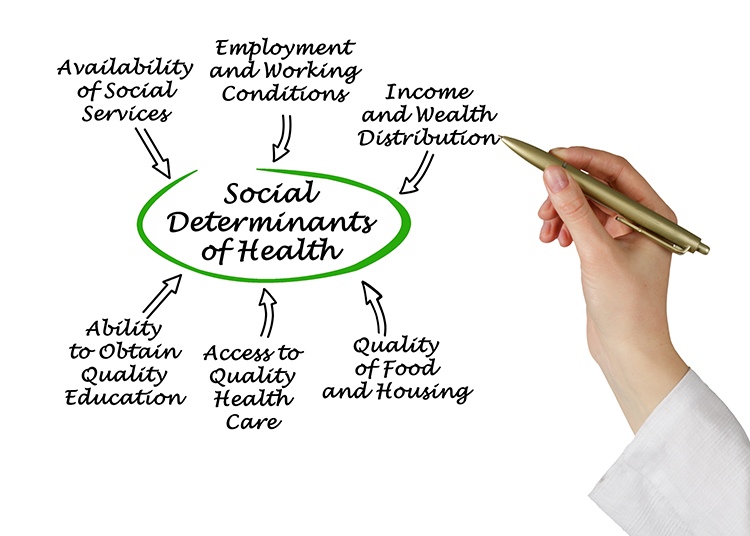
Healthy People has made strides in reducing preventable diseases and injuries through the creation and monitoring of quantifiable objectives, yet we still lag on key health and well-being measures compared to our global counterparts. Now into its 5th decade, Healthy People's vision is to "achieve full potential for health and well-being across the life-span." To reach this vision, the Social Determinants of Health (SDOH) is a key overarching goal within the Healthy People 2030 initiatives. The initiatives attached to this goal include reducing health inequities using upstream approaches. What exactly are upstream approaches and what are some of the challenges and opportunities in this domain?
SDOH often refers to non-medical factors that impact overall health such as knowledge, attitudes, and beliefs about medical conditions and how every day choices including where we live, our socio-economic status, education levels, and race/ethnicity play a role in our health outcomes. Typically, the social and environmental factors related to SDOH span a spectrum of areas including both upstream and downstream factors. To better understand the impact of SDOH, a popular visual representation by Dahlgren and Whitehead's Social Model of Health is often cited. This model uses a social ecological approach in describing the relationship between health and individual lifestyle factors; social and community networks; and socio-economic, cultural, and environmental factors. The Bay Area Regional Health Inequities Initiative Framework further elucidates on upstream approaches in addressing health equity using health policy.
Upstream services focus on macro level factors such as structures that impact health whereas downstream services focus on providing equitable access to care. For example, addressing income from an upstream initiative is to advocate for living wage policies, wage capping, and progressive taxation whereas a downstream imitative would be to address income to ensure that chronic disease prevention programs are accessible to people who have low income.
Upstream interventions can be tackled through health policy that impact systems such as structures or broad-based initiatives such as health insurance. These macro level interventions can be challenging to assess due to the complexity in pathways and links to direct health outcomes, and they often have a long-term yield. In other words, it takes an upfront investment of resources, but the results won't be seen until years later. For example, we now know where you live ¬ (i.e. your zip code) can influence your overall health as well as how long you live. To improve health outcomes using upstream initiatives such enhancing residential areas by adding parks, walkways, and green spaces and addressing food deserts through policy change have shown to have a direct impact on health, but it may take up to a year and at times even a decade to see results. , Measuring the impact of these initiatives can also be difficult and will require accurate measures, shared terminology, and robust longitudinal studies. Stakeholders need to recognize that interventions and investment today are not going to yield quick outcomes.
Increased efforts in addressing the SDOH by public health agencies, health systems, and community partners are underway. By having overarching goals within the Healthy People initiatives, an accountability structure is in place to track its progress. In addition, with the recent passage of H.R.4004 - Social Determinants Accelerator Act of 2019, it is anticipated more work will be done to further improve interagency collaboration and community partnerships using evidenced based frameworks to improve health outcomes. Hopefully by 2030, we will reflect on this decade and see how far we have come on impacting overall health by reducing health inequities using robust upstream intervention models.
Author Bio:

Huma Shah, DrPH,MPH, FACHE
Dr. Shah is the Program Director of the Master's in Healthcare Administration Program and Assistant Professor at the School of Public Health. Her research interests include organizational strategy/culture, health policy, leadership, clinical outcomes, and spirituality in the workplace.
Reference
- Healthypeople.gov. (2020, October 8). What is the Healthy People 2030 framework? https://www.healthypeople.gov/2020/About-Healthy-People/Development-Healthy-People-2030/Framework
- Healthy People 2030. (n.d.). Social determinants of health. Retrieved May 11, 2021 from: https://health.gov/healthypeople/objectives-and-data/social-determinants-health
- Bharmal, N., Derose, K.P., Felician, M., & Weden, M.M (2020, May). Understanding the upstream Social Determinants of Health: Working Paper. Rand Health. https://www.rand.org/content/dam/rand/pubs/working_papers/WR1000/WR1096/RAND_WR1096.pdf
- Saha, S., Loehrer, S., Cleary-Fisherman, M., Johnson, K., Chenard, R., Gunderson, G., Goldberg. R., Little, J., Resnick, J., Cutts, T., and Barnett K. (201). Pathways to population health: An invitation to health care change agents. Institute for Healthcare Improvement. www.ihi.org/P2PH
- Bay Area Regional Health Inequities Initiative (2020). BARHII. https://www.barhii.org/barhii-framework
- Fish, K. & Moffatt, H. (n.d.) Let's talk moving upstream. National Collaborating Center for Determinants of Health. https://nccdh.ca/images/uploads/Moving_Upstream_Final_En.pdf
- Williams, D. R., Costa, M. V., Odunlami, A. O., & Mohammed, S. A. (2008). Moving upstream: how interventions that address the social determinants of health can improve health and reduce disparities. Journal of public health management and practice: JPHMP, 14 =(Suppl), S8–S17. https://doi.org/10.1097/01.PHH.0000338382.36695.42
- Robert Wood Johnson Foundation. (n.d.). Life expectancy: Could where you live influence how long you live. Retrieved on May 11, 2021 from: https://www.rwjf.org/en/library/interactives/whereyouliveaffectshowlongyoulive.html
- H.R.4004 - 116th Congress (2019-2020): Social Determinants Accelerator Act of 2019. (2019, July 26). https://www.congress.gov/bill/116th-congress/house-bill/4004
